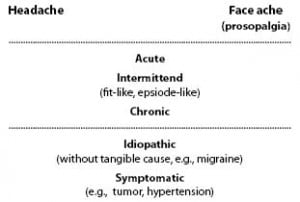Headache is common, but its causes can be very different. Often it requires an thorough interdisciplinary examination by, for example, internists, neurologists, ENT specialists, orthopedics and ophtalmologists.
The acute headache has to be differentiated from the chronic and persistent, and the intermittend, recurring types of headache.
The subarachnoidal hemorrhage (SAH) is an important cause of the acute, newly occuring headache. SAH is an intracranial (inside the skull) bleeding, which is caused by a vessel malformation, a so-called aneurysm. The bleeding (or the aneurysm, respectively) has to be treated very quickly since it is a life-threatening disease.
Other causes of a newly occuring headache can be paranasal inflammations, or eye diseases accompanied by changes of the visual system.
Cerebral hemorrhage caused by a hypertensive crisis (increase of blood pressure above preexisting values) also lead to severe headache. But it is accompanied by neurological deficits (paralyzations, speech disorders, vision deficiency).
Even a cerebral infarction resulting from ischemia (restriction in blood supply) can make its presence felt simply by severe acute headache.
Causes of intermittent headache are migraine, different forms of face ache (prosopalgia), or neuralgia (for instance, trigeminal neuralgia), or mechanical blockade of cervical spine (e.g., first cervical vertebra).
Chronic persistent headache is a diagnostic challenge and can have many causes, which has to be analyzed in each individual case. Causes are arterial hypertension (blood pressure change above normal levels), chronic paranasal inflammation and many more. Even psychological issues matter in case of chronic headache.
All types of headache can also be engendered by a tumor or intracranial space-occupying lesions. A space-occupying lesion can emerge if a tissue expands. Therefore, an exhaustive examination including detailed anamnesis is very important ensued by indicated corresponding examinations (blood sample analysis, EEG, CT, MRI, cerebrospinal puncture / spinal tap, etc.).


